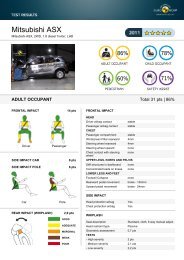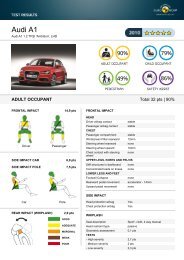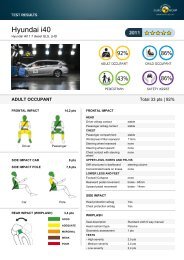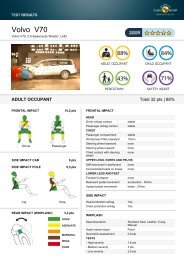Whiplash Testing Protocol - Euro NCAP
Whiplash Testing Protocol - Euro NCAP
Whiplash Testing Protocol - Euro NCAP
Create successful ePaper yourself
Turn your PDF publications into a flip-book with our unique Google optimized e-Paper software.
6.2.3.1.5.4 If there is no locking position before the lowest or stowed position is reached, then the<br />
head restraint should be positioned fully down.<br />
6.2.3.1.5.5 Once the vertical test position has been determined, ensure the head restraint is returned<br />
to rearmost tilt position.<br />
Version 3.1<br />
June 2011<br />
Example A<br />
Locking position at<br />
geometric mid point<br />
Locking positions are indicated in orange<br />
Example B<br />
Locking position up to<br />
10mm above geometric<br />
mid point<br />
Figure 8: Examples of test position for head restraints with various locking configurations<br />
6.2.3.2 Setting of mid range tilt (locking tilt settings only)<br />
Example C<br />
Locking position more<br />
than10mm above<br />
geometric mid point<br />
6.2.3.2.1 Following the setting of midrange height, the procedure should be repeated for locking<br />
horizontal adjustments. For non-locking tilt adjustments, the head restraint should be<br />
tilted fully rearward.<br />
6.2.3.2.2 Mid tilt position may be influenced by the presence of the HRMD head, consequently the<br />
setting of mid range tilt should be undertaken following successful installation of the<br />
H-point machine and HRMD and should be completed while the equipment is still<br />
installed in the seat.<br />
6.2.3.2.3 For HRMDs equipped with probes having 5mm increments only, a more accurate<br />
measurement technique is required to establish the mid position to within 1mm. Using a<br />
steel rule, measure the probe extension from the front of the headform at forward and<br />
rearward tilt settings. From this data a midpoint target may be derived.<br />
6.2.3.2.4 Most rearward tilt shall be made using HRMD probe backset. The most rearward tilt<br />
position shall be that which results in greatest backset measurement. In the situation<br />
where the head restraint cannot be placed at most rearward tilt. For example due to a<br />
20
















